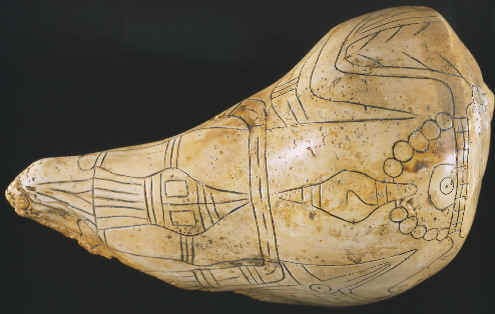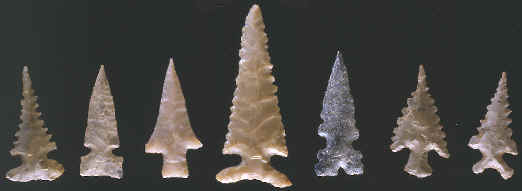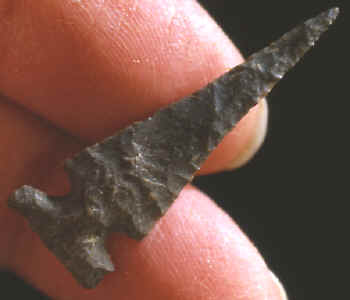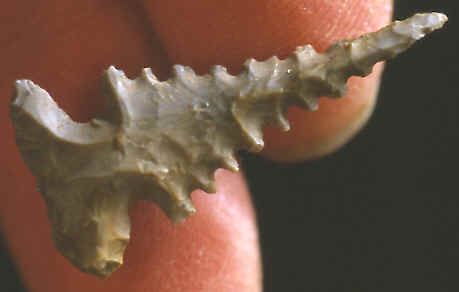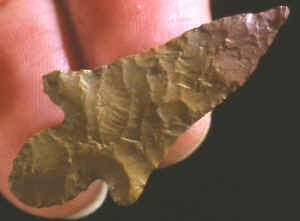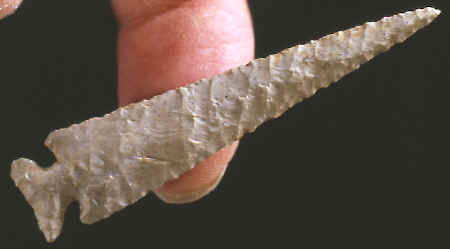When the Pocola Mining Company needed more people to dig the main cone of this huge mound they hired coal miners. Rather than dig craters from above in the vast area of earth on the main cone they decided to gamble with digging one large tunnel through the center and, as reported, "hit pay dirt." This tunnel was large enough to get a wheel borrow through but other tunnels were much smaller. They eventually dug many tunnels that honey combed the area inside the largest cone of Craig Mound. What is amazing is they never used shoring in these tunnels and no one was ever injured from a cave in! The significance of what was happening at Spiro didn't become known to the scientific community and to people outside the local area until artifacts began to be sold on the eastern antiquities market. Forrest E. Clements of the Department of Anthropology at the University of Oklahoma first heard of the site and the large numbers of unknown types of artifacts in December, several months after digging had begun. At first, many believed the artifacts might be forgeries but they soon realized this was a major archaeological find. Other professionals such as Thorne Deuel, chief of the Illinois State Museum, and Robert E. Bell, who later became an archaeologist, visited Craig Mound during its destruction. Robert Bell was instrumental in documenting large numbers of the artifacts found there.
It didn't take long for many people to realize there was a
need for some type of state law that would have control over or prevent
such blatant destruction of important archaeological sites in the future.
In the spring of 1935 the Oklahoma legislative past an antiquities act.
Prior to this Clements was trying to slow down the diggers. He tried to
buy them out with a handsome profit but was unsuccessful. But he was
successful in keeping their main digging activity away from the main cone
for awhile. The diggers paid no attention to the new law until the deputy
sheriff paid them a visit one day in the summer of 1935. After they were
informed of their illegal act of digging and "several threats of
mayhem" they gathered up their tools and left. The most important
area within the highest cone of Craig Mound was far from being dug out.
Everything was look-in good. At this point the main cone on Craig Mound was pretty well intact and Clements believed the battle was won. So, not worrying about the sites destruction anymore, he took a summer teaching appointment in California and left. Most of the people who lived in the area were living within a rural community and they were not interested in new laws from the big cities that put more controls on their land and archaeology was not an important issue. No one really cared to enforce the law so when everybody left and Clements wasn't around to check up on things the diggers moved back in and finished out their lease which ran until the end of summer.
He must have been devastated when he discovered his mistake
of believing every thing would be ok after the diggers were told to leave
by the deputy. Nothing was left. The destruction was almost complete. He
wrote "the great mound had been tunneled through and through, gutted
in a frenzy of haste. Sections of cedar poles lay scattered on the ground,
fragments of feather and fur textiles littered the whole area. It was
impossible to take a single step in hundreds of square yards around the
ruined structure without scuffing up broken pieces of pottery, sections of
engraved shell, and beads of shell, stone and bone." The main tunnel
entrance into the large mound was later blown-up with explosives after
the Pocola Mining Company left the property. No one seems to know for
sure who closed the tunnel. It may have been
done for the purpose of closing off the dangerous tunnels that were
still inside the mound.
By this time, newspapers such as the Kansas City Star, were
beginning to write exaggerated stories that compared the Craig Mound, now
being called "The Great Temple Mound", to
King Tut's Tomb. These stories served, for a time, to inflate some of the
prices of artifacts and more diggers and dealers were bidding against each
other to George Evans to acquire a new lease from the owners of the
"Great Temple Mound". Clements writes "tales of
pearls by the bushel began to circulate. One man declared that Tiffany's
in New York had valued a quart of Spiro pearls at half a million
dollars". Fakes also began to be turned out in large numbers. By this time the digging of the "Great Temple Mound" had become more of a legend. It actually became many things depending on who was telling the story. The professional community saw it as a tragic loss. On the other hand there were many people who had no interest in science and saw the mounds only as a place to find treasure. Many of the stories being written were exaggerations and embellishments of previous stories. Since so much of the excavation was done in secrecy people were writing their own accounts of what was inside the burial chamber. A comparison was made with King Tut's tomb complete with the curse and this was connected with the three deaths that happened during the two years of digging. They were R. W. Wall who was found drowned in a shallow stream, James Craig who "died in the shadow of the mound" with Tuberculosis and a country lawyer who opposed the antiquities bill and died unexpectedly just before the vote. A lot of the information written about Craig Mound is not accurate. The focus of most of these stories centers around the "central tomb", "kings tomb", "chiefs tomb" or "central cavity".
The
University of Oklahoma began a systematic excavation of Craig Mound in
1936 with the WPA to try and work out some of the mysteries surrounding
the first excavation. Their excavation lasted for three years completely
removing the mound. One of their goals was to learn as much as possible
about the small cedar log structure known as the central cavity. So many
exaggerated stories had been written they wanted to know for one thing,
how large it may have been. Clements wrote that the University's
excavation found an irregular cavity that varied in size from 15 to 20
feet wide and perhaps eight feet to the center of the roof. But the
diggers tools marks were "thick over the clay-like walls". The
diggers had removed the cedar logs and extended the size of the original
cavity. Two estimates of the size of the central cavity was given by the
Kansas City Star and Glen Groves. Both said the opening was tipi (tepee)
shaped
and 14 feet in diameter. Clements estimated 30 cedar poles had been left
behind by the diggers. |
||||||
|
"REFERENCES"
|
||||||
